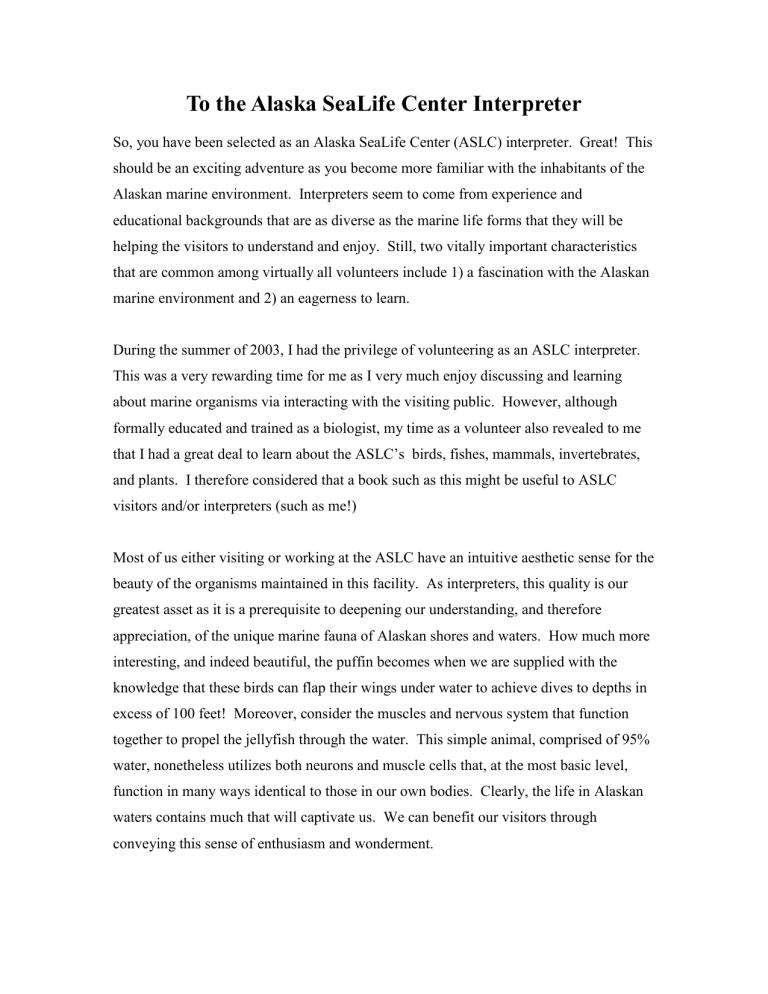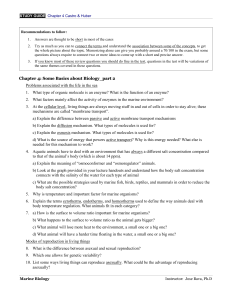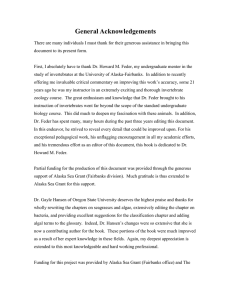To the Alaska SeaLife Center Interpreter

To the Alaska SeaLife Center Interpreter
So, you have been selected as an Alaska SeaLife Center (ASLC) interpreter. Great! This should be an exciting adventure as you become more familiar with the inhabitants of the
Alaskan marine environment. Interpreters seem to come from experience and educational backgrounds that are as diverse as the marine life forms that they will be helping the visitors to understand and enjoy. Still, two vitally important characteristics that are common among virtually all volunteers include 1) a fascination with the Alaskan marine environment and 2) an eagerness to learn.
During the summer of 2003, I had the privilege of volunteering as an ASLC interpreter.
This was a very rewarding time for me as I very much enjoy discussing and learning about marine organisms via interacting with the visiting public. However, although formally educated and trained as a biologist, my time as a volunteer also revealed to me that I had a great deal to learn about the ASLC’s birds, fishes, mammals, invertebrates, and plants. I therefore considered that a book such as this might be useful to ASLC visitors and/or interpreters (such as me!)
Most of us either visiting or working at the ASLC have an intuitive aesthetic sense for the beauty of the organisms maintained in this facility. As interpreters, this quality is our greatest asset as it is a prerequisite to deepening our understanding, and therefore appreciation, of the unique marine fauna of Alaskan shores and waters. How much more interesting, and indeed beautiful, the puffin becomes when we are supplied with the knowledge that these birds can flap their wings under water to achieve dives to depths in excess of 100 feet! Moreover, consider the muscles and nervous system that function together to propel the jellyfish through the water. This simple animal, comprised of 95% water, nonetheless utilizes both neurons and muscle cells that, at the most basic level, function in many ways identical to those in our own bodies. Clearly, the life in Alaskan waters contains much that will captivate us. We can benefit our visitors through conveying this sense of enthusiasm and wonderment.
In order to deepen one’s understanding of the numerous ASLC species, this manual contains both an overview of those characteristics which constitute living systems in general as well as a description of marine ecosystems and organisms in particular. You are encouraged to focus initially on the broad themes (e.g., what is a living thing?, what is an ecosystem?, and how are organisms scientifically classified?) presented in this book’s initial chapters. Understanding these should provide you with a general background that will prove useful in understanding the details of the species, covered later in this booklet, that you’ll be presenting to visitors.
If you have not had much formal education/training in biology you can nonetheless be a very effective ASLC interpreter. The very fact that you have agreed to take on the role of an interpreter signifies above average interest in the Alaskan marine environment. This booklet, written from the perspective that the reader lacks college-level, biology course work, is an attempt to bring all interpreters up to a more level playing field for understanding Alaska’s marine organisms. I hope that it may help to achieve this and that your time as an interpreter will therefore be more rewarding to both inquiring visitors and to you as well.
John M. Uscian, August, 2004








